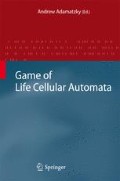Abstract
The de Bruijn diagram describing those decompositions of the neighborhoods of a one dimensional cellular automaton which conform to predetermined requirements of periodicity and translational symmetry shows how to construct extended configurations satisfying the same requirements. Similar diagrams, formed by stages, describe higher dimensional automata, although they become more laborious to compute with increasing neighborhood size. The procedure is illustrated by computing some still lifes for Conway’s game of Life, a widely known two dimensional cellular automaton. This paper is written in September 10, 1988.
Access this chapter
Tax calculation will be finalised at checkout
Purchases are for personal use only
Preview
Unable to display preview. Download preview PDF.
References
Berlekamp, E.R., Conway, J.H., Guy, R.K.: Winning Ways for Your Mathematical Plays, vol. 2, Chap. 25. Academic Press, San Diego (1982). ISBN 0-12-091152-3
Gardner, M.: Mathematical Games — The fantastic combinations of John Conway’s new solitaire game “life”. Sci. Am. October 120–123 (1970)
Gardner, M.: Wheels, Life, and Other Mathematical Amusements. Freeman, New York (1983). ISBN 0-7167-1589-9 pbk
Golomb, S.W.: Shift Register Sequences. Holden-Day, San Francisco (1967)
McCulloch, W.S., Pitts, W.: A logical calculus of the ideas immanent in nervous activity. Bull. Math. Biophys. 5, 115–133 (1943)
Ralston, A.: De Bruijn sequences — A model example of the interaction of discrete mathematics and computer science. Math. Mag. 55, 131–143 (1982)
von Neumann, J.: Theory of Self-reproducing Automata. Edited and completed by Burks, A.W. University of Illinois, Champaign (1966)
Wainwright, R.T. (ed.): Lifeline, a quarterly newsletter with 11 issues published between March 1971 and September 1973
Wolfram, S.: Computation theory of cellular automata. Commun. Math. Phys. 96, 15–57 (1984)
Wolfram, S. (ed.): Theory and Applications of Cellular Automata. World Scientific Press, Singapore (1986). ISBN 9971-50-124-4 pbk
Author information
Authors and Affiliations
Corresponding author
Editor information
Editors and Affiliations
Rights and permissions
Copyright information
© 2010 Springer-Verlag London Limited
About this chapter
Cite this chapter
McIntosh, H.V. (2010). Life’s Still Lifes. In: Adamatzky, A. (eds) Game of Life Cellular Automata. Springer, London. https://doi.org/10.1007/978-1-84996-217-9_4
Download citation
DOI: https://doi.org/10.1007/978-1-84996-217-9_4
Publisher Name: Springer, London
Print ISBN: 978-1-84996-216-2
Online ISBN: 978-1-84996-217-9
eBook Packages: Computer ScienceComputer Science (R0)

